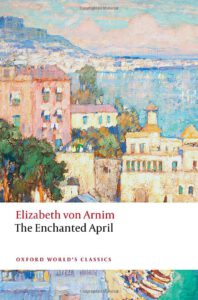by Francesca Pierini
The notion of Italy as a country relatively free of class constraints and stark social divisions – a space appropriate for returning to unaffected behaviour, sensual openness, and existential re-invention – is part of a composite constellation of counter-values to British standards and ideals that have been most diversely imagined and articulated by a variety of authors writing in English.
Elizabeth von Arnim’s The Enchanted April (1922), a novel greatly successful at the time of its publication, re-articulates, in a distinctively brilliant and light-hearted key, the necessity to relinquish excessive attachment to duty, social restrictions, and posturing, in order to expand one’s existential possibilities.1) It does so by substantially investing in the creation of an Italian garden as a parallel dimension of psychological healing, as well as a time-capsule in partial discontinuity with the modern world. The multi-coloured, abundantly luxuriant, and anarchic character of the flora in the gardens of Villa San Salvatore, where most of the drama takes place, mirrors the casual encounter of the four heroines at the centre of the novel’s narration.
This space, plentiful and sunny, functions as the main stage for the protagonists’ much needed rest, voluntary exile, introspection, falling in love, and healing. It will perform a spell on the four protagonists, offering them the opportunity to “fix” broken or neglected aspects of their lives.
Gradually, in contact with this space animated by a benevolent spirit, the four ladies’ personalities evolve into the opposites of what they initially were or appeared to be. Alongside these individual personal “macro-trajectories,” there are subtler ones pertaining to how the ladies “find themselves” in connection and reaction to one another. By leaving behind initial reluctancies, personal idiosyncrasies, and mutual distrust, all ladies flourish through mutual interaction, allowing themselves to connect beyond their different social statuses, personalities, and age. Just like flowers, they thrive in this messy arrangement, learning from one another, each contributing to the other’s development and well-being.
The novel stages an allegory of growth and personal transformation centred on a re-joining of the intellect with the soul and the body. By framing the chaotic clashing of statuses and personalities within the old walls of Villa San Salvatore, von Arnim creates the space for the resolution of the novel’s conflicts at the same time as she reiterates the manageable and beneficial character of this kind of chaos.
Recent scholarship on Elizabeth von Arnim has brought to light the tangible but intricate motives that warrant analyses of von Arnim’s supposedly “evasive” narratives in light of politics and imperial aesthetics, as well as collective concerns pertaining to the role and status of England within the European taxonomy of nations. This has been chiefly done in relation to the author’s writing about Germany, a subject occupying a substantial space in von Arnim’s early production and recurring throughout her career (see, e.g., Maddison; Shepherd).
Whereas Isobel Maddison reads Elizabeth and Her German Garden (1898), von Arnim’s first published and most successful novel, as a representative of “invasion-scare” literature, Jennifer Shepherd recurs to the genre of the imperial adventure novel to shed light on important aspects of von Arnim’s literary imagination.2)
Shepherd suggests the possibility of reading von Arnim’s “German garden books” from the perspective of the imperial adventure novel narrative formula, which postulated an English hero leaving civilization behind to penetrate an exotic and often hostile space which would challenge him and ultimately confirm the superiority of his values. Shepherd convincingly argues that von Arnim “translates” the narrative model of the adventure novel within a domestic setting, staging different grounds for the female protagonist’s adventures into foreign traditions and taste. The conflict, albeit less direct and muscular, is no less interesting to explore, as it constitutes the focus of a “battle of taste” – concerning English and German houses and gardens – which expresses deeper conflicts and anxieties related to politics and national identity.
Although in The Enchanted April the narrative focus shifts to Italy, a Southern European location geo-politically unthreatening and peripheral, it still reflects an interest in distinction and hierarchy. Precisely by virtue of a taken for granted lack of possible confrontation on an equal (political, military, economic) footing with the Italian context, assumptions on the supposed superiority of English civilization become more legible, at times almost transparent.
The Enchanted April is not characterized by a conflict – direct or mediated – with Italians and/or Italian culture. The confrontation with otherness, therefore, is rather abstract and solipsistic, concerning England and its own allegedly “simpler past.” The microcosm the narrative builds is thoroughly English, a piece of contemporary England set within a pastoral environment in which the English ladies learn and change. Their time at San Salvatore is at the same time immersed in an imagined construct as it is detached (protected) from “real” Italy.
The English ladies may “discover” Italy for a monthly fee, may be gently and momentarily challenged by it, and, just as the tradition of the imperial adventure novel dictates, may come out from this interlude “emerging at the top:” confirmed in their superior social position and education but restored to better versions of themselves.3) The novel makes apparent the perception of Italy as a country not coeval with England or Germany but seen as an extension – the garden – of “proper” Europe. This sensory space – not depicted as politically and socially dynamic, replete with modern challenges, estrangements, and alienations – is a bounded counter-home, an essentially aesthetic space of orderly chaos and a “pastoral enclave” (Maddison 179).
By placing its protagonists within a bounded space of natural beauty, blissfully chaotic but still manageable and cultivated, von Arnim illustrates England’s relationship to Italy as an imagined connection to a “faintly oriental” domain frequently functioning, in Anglophone narratives of the time, as the privileged context for a (mild) challenging and subsequent restoration of (the British normative) self through the rediscovery of natural and unaffected existential values.
Works Cited
Arnim, Elizabeth von. Elizabeth and Her German Garden. London: Virago, 2003.
Arnim, Elizabeth von. The Enchanted April. Oxford: OUP, 2022.
Maddison, Isobel and Elizabeth von Arnim. Beyond the German Garden. London: Routledge, 2016.
Shepherd, Jennifer. “Digging for England in Elizabeth’s German Garden: Imperial Romance and National Femininities in the Early Works of Elizabeth von Arnim.” Women: A Cultural Review 28,1–2 (2017): 7–21.

